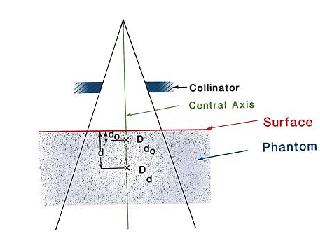Percentage
Depth Dose
Home > Treatment Planning > Prescription & Dose Calculation > Dose Calculation and Verification
> Percentage Depth Dose
Can we please get your advice on this one question?
One way of characterizing the central axis dose distribution is to normalize dose at depth with respect to dose at a reference depth. The quantity percentage (or simply percent) depth dose may be defined as the quotient, expressed as a percentage, of the absorbed dose at any depth d to the absorbed dose at a fixed reference depth d0, along the central axis of the beam
P.D.D = (Dd / Ddo ) X 100

Figure (a) shows the setup measurement for P.D.D
The percentage depth dose (beyond the depth of maximum dose) increases with beam energy. Higher-energy beams have greater penetrating power and thus deliver a higher-percentage depth dose (Fig. 9.3). If the effects of inverse square law and scattering are not considered, the percentage depth dose variation with depth is governed approximately by exponential attenuation. Thus, the beam quality affects the percentage depth dose by virtue of the average attenuation coefficient µ.2 As the µ decreases, the more penetrating the beam becomes, resulting in a higher percentage depth dose at any given depth beyond the build-up region
For a sufficiently small field one may assume that the depth dose at a point is effectively the result of the primary radiation, that is, the photons that have traversed the overlying medium without interacting. The contribution of the scattered photons to the depth dose in this case is negligibly small or 0. But as the field size is increased, the contribution of the scattered radiation to the absorbed dose increases. Because this increase in scattered dose is greater at larger depths than at the depth of Dmax, the percent depth dose increases with increasing field size. The increase in percent depth dose caused by increase in field size depends on beam quality. Since the scattering probability or cross section decreases with energy increase and the higher-energy photons are scattered more predominantly in the forward direction, the field size dependence of percent depth dose is less pronounced for the higher-energy than for the lower-energy beams.
Photon fluence emitted by a point source of radiation varies inversely as a square of the distance from the source. Percent depth dose increases with SSD because of the effects of the inverse square law.
Questions:
1. P.D.D increases with
a) Field size
b) SSD
c) Energy of the beam
d) All
2. Dose maximum for the Co60 is at
a) 1.5 cm
b) 0.5 cm
c) 0.2 cm
d) 1.0 cm
Answer:
1. d) All
2. b) 0.5 cm
References:
1. The Physics of Radiation Therapy by F. M. Khan
2. www.wikipedia.com
3. www.medicalphysics.org
FREE Infographic What successful people believe. What successful people do
Dictionary of Cancer Terms
Need help understanding a word? Here is an electronic resource that gives meaning to Cancer terms and their usage.

StrengthsFinder 2.0
